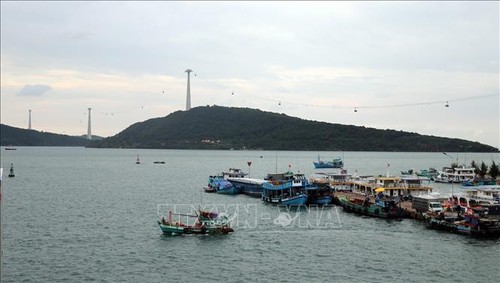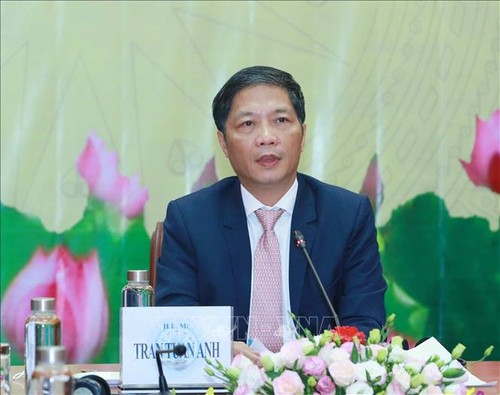 An Thoi-Hon Thom cable car in Phu Quoc island district. (Photo: Le Huy Hai/VNA) An Thoi-Hon Thom cable car in Phu Quoc island district. (Photo: Le Huy Hai/VNA) |
The Vietnamese Government issued a Resolution on the Master Plan and 5-year plan to implement Resolution 36, specifying tasks and solutions until 2025 and a list of 51 projects for ministries, sectors, and localities. Eight coastal cities and provinces established Steering Committees and 28 cities and provinces issued Action Programs to carry out the Party’s Resolution.
Development of maritime economy and coastal localities
The volume of goods transported through Vietnam's seaports in 2022 totaled 733 million tonnes. Vietnam's seafood export turnover earned a record 11 billion USD. Wind power and solar power projects have developed strongly in the central and southern coastal provinces, including Ninh Thuan, Phu Yen, Bac Lieu, Soc Trang, and Can Gio district of Ho Chi Minh City.
Vietnam has 19 coastal economic zones with a total land and water surface of 845,000 ha.
Associate Professor Doctor Tran Dinh Thien, former Director of the Vietnam Institute of Economics and member of the Prime Minister’s Economic Advisory Group, said that the development planning of the coastal provinces has been greatly improved while maritime economic zones have continued to develop strongly, becoming important maritime economic bases.
“For example, Phu Quoc, Van Phong, Van Don, and Ha Long have seen great changes. We will have systematic development in the future,” said Thien.
Along with the development of coastal economic and industrial zones, the urbanization rate of 28 coastal provinces and cities reached 39.5%, higher than the national average of 37.5%. Vietnam has formed four coastal economic regions, including the northern coast from Quang Ninh to Ninh Binh province, the Northern Central and Central coast from Thanh Hoa to Binh Thuan province, the Southeast from Ba Ria-Vung Tau to Ho Chi Minh City, and the Southwestern region from Tien Giang to Kien Giang province.
By the end of last year, more than 200,000 ha of sea and islands had been zoned for conservation. So far 17 of 28 coastal provinces and cities have approved the list of coastal protection corridors.
Vietnam has signed and implemented agreements on information sharing and coordination between Vietnam's navy, coast guard, and other forces and India, Japan, China, and Cambodia. Hotlines have been maintained between Vietnam’s navy and the navies of Brunei, Cambodia, Thailand and other coastal countries to support fishermen and ensure maritime order and safety.
 Tran Tuan Anh, a Politburo member and Head of the Party Central Committee’s Economic Commission. (photo: VNA) Tran Tuan Anh, a Politburo member and Head of the Party Central Committee’s Economic Commission. (photo: VNA) |
Continued development of maritime economy
Tran Tuan Anh, a Politburo member and Head of the Party Central Committee’s Economic Commission, said, “We have to develop faster and more sustainably. It’s necessary to harmonize development, environmental protection, and maritime biodiversity preservation, while responding to climate change and sea water rise, protecting people’s lives, and developing marine culture. These are the orientations mentioned in Resolution 36.”
“In the implementation process, it’s necessary to continue to analyze and clarify the situation in order to create appropriate mechanisms, policies, and solutions.”
From now until 2025, ministries, sectors, and localities will continue to fine-tune the national marine spatial planning for the 2021-2030 period, with a vision to 2050, and the Master Plan on sustainable exploitation and use of coastal resources in the 2021-2030 period, with a vision to 2045, to ensure regional connectivity between coastal and landlocked localities.
Ministries, sectors, and localities will also complete a survey on the environment and resources of sea and islands by 2030; the National Action Plan on ocean plastic waste management to 2030; the Program to strengthen capacity and modernize infrastructure for the management of natural resources and environment of sea and islands by 2030; and allocate resources to achieve the set targets.
Coastal localities will form Steering Committees and work closely with the Department of Sea and Islands of the Ministry of Natural Resources and Environment to effectively implement tasks for sustainable maritime economic development.